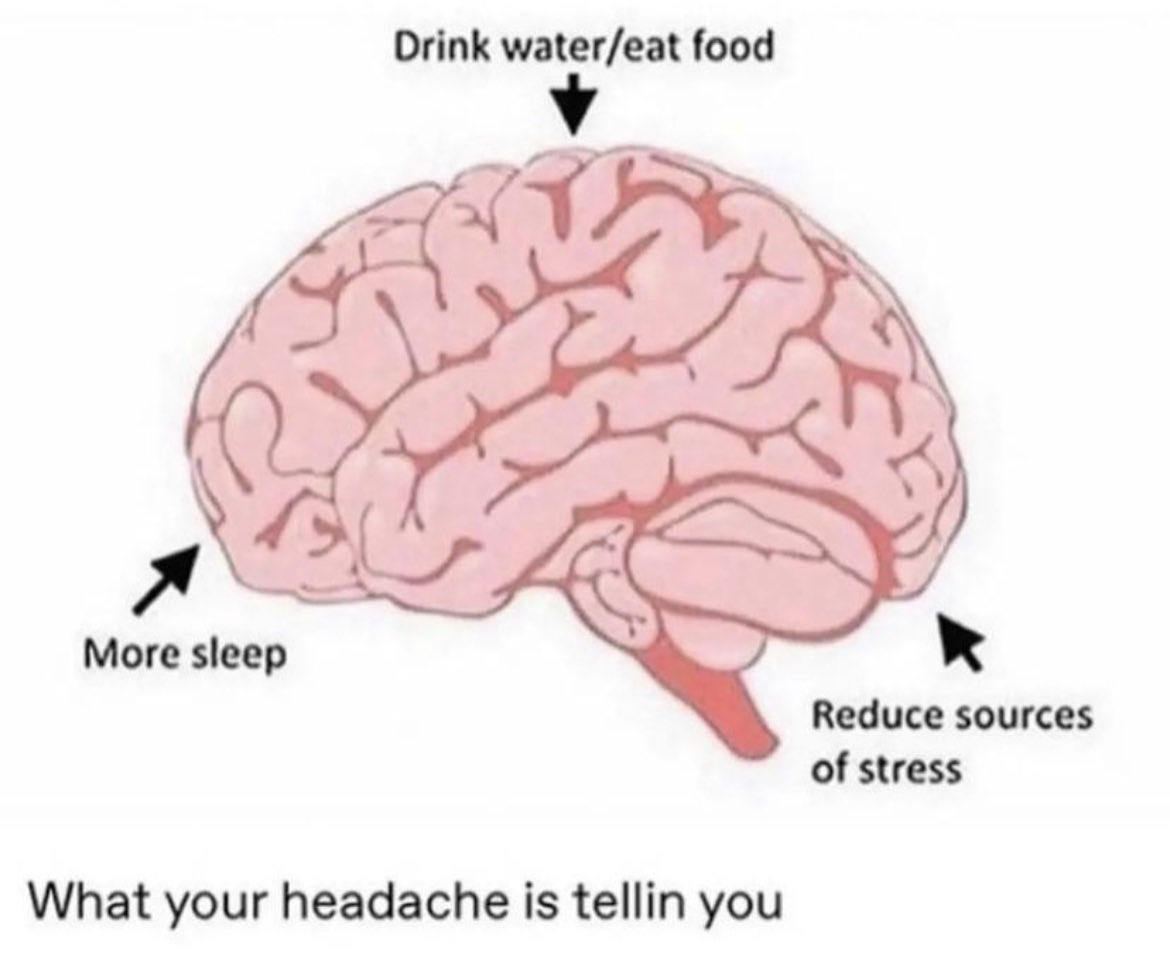What the location of your headache means. Headache Locations: What They Reveal About Your Pain and Health
Where is your headache located. What does the location of your headache mean. How can headache locations help diagnose your condition. Which headache types are associated with specific head regions.
Whole-Head Headaches: Causes and Characteristics
Whole-head headaches, often described as feeling like a tight band around the head, are typically indicative of tension headaches. These are the most common primary headache disorders, affecting a significant portion of the population. However, it’s crucial to note that migraine pain can sometimes be holocranial, meaning it can be felt around the entire head rather than just on one side.
Tension headaches usually involve pain and pressure that may extend to the neck, along with discomfort and tenderness around the forehead. These headaches are primarily caused by muscle contractions in the head and neck regions. While they typically last for a few hours, some cases can persist for days.
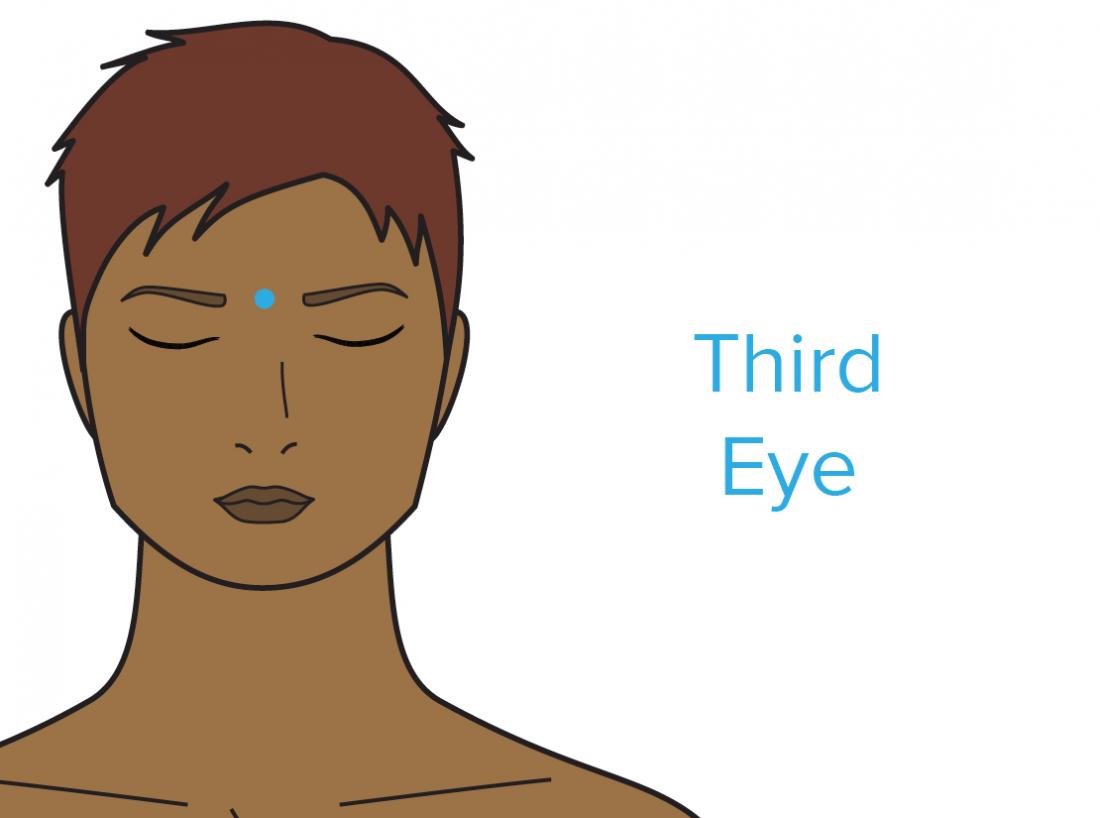
Common Triggers for Whole-Head Headaches
- Stress
- Neck problems
- Caffeine withdrawal
- Physical exertion
- Hunger
- Hangover
- Fatigue
- Cold or flu
- Head trauma
- Eye strain or prolonged computer use
- Overuse of headache medication (rebound headache)
While occasional tension headaches generally don’t require medical attention, it’s advisable to consult a doctor if you experience 15 or more headache days per month, as this may indicate a chronic condition requiring professional intervention.
One-Sided Headaches: Migraines and Cluster Headaches
When head pain is concentrated on either the left or right side, it often points to migraine or cluster headaches. These primary headache disorders have distinct characteristics and triggers that set them apart from other types of headaches.
Migraine: Symptoms and Triggers
Migraines are recurrent attacks characterized by throbbing, pulsating pain, often accompanied by additional symptoms:
- Nausea or vomiting
- Aura (visual disturbances)
- Sensitivity to noise, light, and odors
- Difficulty focusing
Migraine attacks can be triggered by various factors, including changes in brain chemicals, particularly a decrease in serotonin levels. Other potential triggers include:
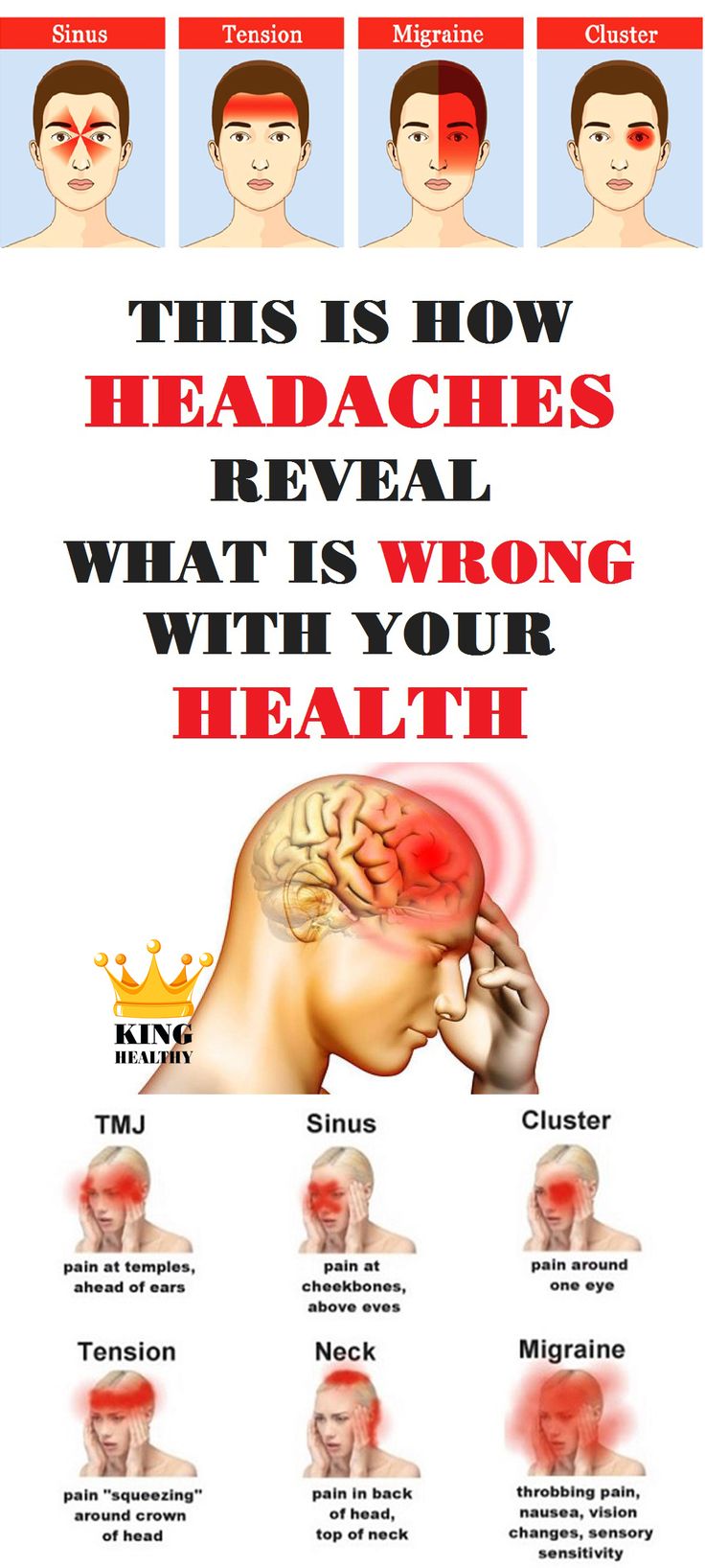
- Loud sounds
- Bright or flashing lights
- Specific odors
- Certain foods
- Weather changes
- Lack of sleep
- Hormonal fluctuations
- Skipping meals
- Dehydration
It’s important to note that triggers can vary significantly from person to person, and sometimes a combination of factors may lead to an attack. Identifying specific triggers isn’t always possible, but keeping a headache diary can help track patterns and potential causes.
Cluster Headaches: Symptoms and Characteristics
Cluster headaches are another type of primary headache disorder causing one-sided pain, often localized behind or around one eye. The pain may spread to the forehead, side of the head, nose, neck, or shoulders on the affected side. These headaches typically occur in cycles or “clusters,” with periods of frequent headaches followed by remission periods.
Cluster headaches are known for their sudden onset and rapid escalation, with pain becoming severe within about 10 minutes of starting. Common symptoms include:
- Burning, stabbing pain behind or around one eye
- Red, teary eye
- Smaller, constricted pupil
- Drooping eyelid
- Puffiness under or around one or both eyes
- Runny or stuffy nose
- Facial flushing
- Restlessness
Both migraines and cluster headaches can be effectively treated and managed once properly diagnosed. It’s essential to consult a healthcare professional for an accurate diagnosis and appropriate treatment plan.
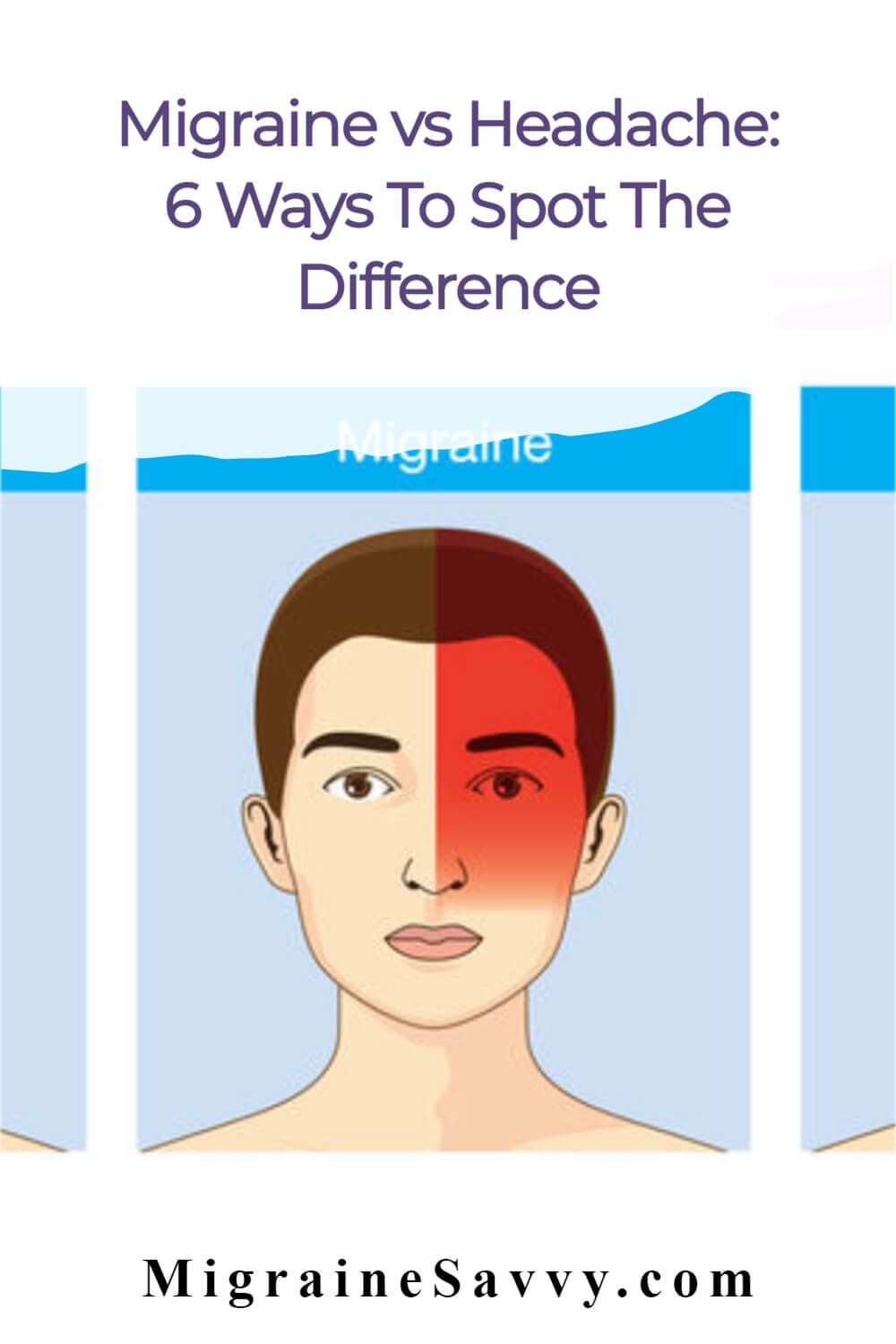
Headaches Behind the Eyes and Nasal Passages: Allergies or Migraines?
Headaches concentrated behind the eyes and nasal passages are often mistakenly attributed to sinus issues or allergies. While allergies like hay fever can indeed cause headache-like symptoms similar to the common cold, true sinus headaches are relatively rare. In many cases, these headaches turn out to be migraines, which can cause pain over the sinus areas.
Contrary to popular belief, headaches behind the eyes are rarely related to eyestrain. If you frequently experience this type of headache and suspect it might be sinus-related, it’s advisable to consult a doctor for a proper diagnosis. A healthcare professional can help determine whether your headaches are truly caused by allergies or if they might be migraines masquerading as sinus pain.
Back of the Head Headaches: Neck Issues and Low-Pressure Headaches
Headaches localized in the back of the head can stem from various causes, with neck problems being a common culprit. Arthritis of the neck, poor posture, or issues like herniated discs can all contribute to pain in this region. These headaches often worsen with movement, making them particularly troublesome for those with active lifestyles.

Another potential cause of back-of-the-head pain is a low-pressure headache, also known as spontaneous intracranial hypotension (SIH). This condition is characterized by low spinal fluid pressure in the brain and typically presents with the following features:
- Pain eases when lying down
- Pain worsens when sitting upright or standing
- Increased discomfort with coughing, sneezing, or straining
- Exacerbation during physical activity
SIH can sometimes occur following a lumbar puncture procedure. If you’ve recently undergone this procedure and develop a headache with these characteristics, it’s crucial to seek medical attention promptly for proper treatment.
The Importance of Proper Diagnosis for Chronic Headaches
Chronic headaches, defined as experiencing 15 or more headache days per month, affect a significant portion of the adult population. Regardless of the location or type of headache you’re experiencing, if it becomes a chronic issue, it’s essential to consult a healthcare provider. Professional evaluation can help determine the underlying cause and guide appropriate treatment strategies.

Proper diagnosis is crucial because different types of headaches may require different approaches to management and treatment. For example, tension headaches might respond well to stress reduction techniques and over-the-counter pain relievers, while migraines or cluster headaches may necessitate more specialized medications or preventive strategies.
When to Seek Immediate Medical Attention
While most headaches are not life-threatening, certain symptoms warrant immediate medical attention. These include:
- Sudden, severe headache often described as the “worst headache of your life”
- Headache accompanied by fever, stiff neck, confusion, or seizures
- Headache following a head injury
- Persistent headache in someone with no prior history of headaches
- Headache associated with vision changes, weakness, or loss of consciousness
These symptoms could indicate more serious conditions such as meningitis, brain hemorrhage, or other neurological issues that require immediate medical intervention.

Lifestyle Factors and Headache Prevention
While understanding the location and characteristics of your headaches is crucial for diagnosis and treatment, prevention plays a key role in managing headache disorders. Several lifestyle factors can significantly impact headache frequency and severity:
Sleep Hygiene
Maintaining a consistent sleep schedule and ensuring adequate sleep duration can help reduce the frequency of many types of headaches, particularly migraines. Aim for 7-9 hours of quality sleep per night and try to go to bed and wake up at the same time each day, even on weekends.
Stress Management
Stress is a common trigger for various headache types, especially tension headaches. Incorporating stress-reduction techniques into your daily routine can be beneficial. Consider practices such as:
- Meditation
- Deep breathing exercises
- Yoga
- Regular physical exercise
- Mindfulness practices
Diet and Hydration
Proper nutrition and hydration play a crucial role in headache prevention. Some dietary considerations include:

- Staying well-hydrated throughout the day
- Identifying and avoiding personal food triggers
- Maintaining regular meal times to prevent low blood sugar
- Limiting caffeine and alcohol intake
Ergonomics and Posture
Poor posture and ergonomics, especially during prolonged computer use or desk work, can contribute to tension headaches and neck pain. Ensure your workspace is ergonomically optimized and take regular breaks to stretch and move around.
Tracking and Managing Your Headaches
Keeping a headache diary can be an invaluable tool in managing and preventing headaches. This practice can help you identify patterns, triggers, and the effectiveness of various treatments. Consider tracking the following information:
- Date and time of headache onset
- Location and intensity of pain
- Associated symptoms
- Potential triggers (e.g., foods, activities, stress levels)
- Medications taken and their effectiveness
- Duration of the headache
Many smartphone apps are available to help you easily log this information. Sharing this data with your healthcare provider can lead to more accurate diagnoses and tailored treatment plans.

Emerging Treatments and Research in Headache Management
The field of headache research is continuously evolving, with new treatments and management strategies emerging. Some recent developments include:
CGRP Antagonists
Calcitonin gene-related peptide (CGRP) antagonists represent a new class of drugs specifically designed for migraine prevention and treatment. These medications work by blocking the action of CGRP, a protein involved in pain transmission during migraine attacks.
Neuromodulation Devices
Non-invasive neuromodulation devices, such as those using electrical or magnetic stimulation, are showing promise in treating various headache disorders. These devices aim to modulate pain pathways in the brain and reduce headache frequency and severity.
Precision Medicine Approaches
Researchers are exploring ways to tailor headache treatments based on an individual’s genetic makeup and other biological factors. This personalized approach aims to improve treatment efficacy and reduce side effects.
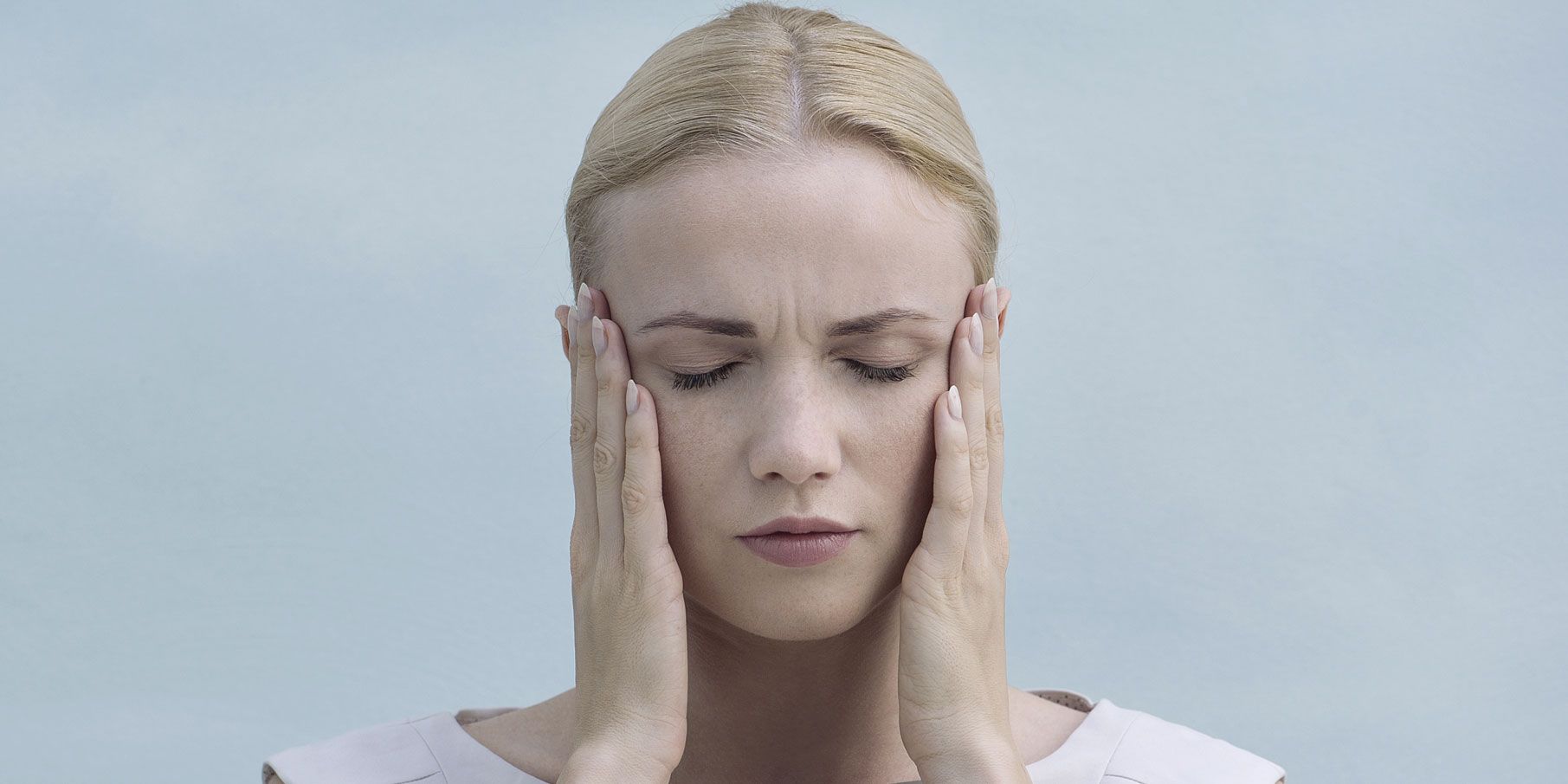
Mindfulness and Cognitive Behavioral Therapy (CBT)
There’s growing evidence supporting the effectiveness of mindfulness practices and CBT in managing chronic headaches. These approaches can help patients develop coping strategies and reduce the impact of headaches on daily life.
As research continues to advance our understanding of headache disorders, new and more effective treatments are likely to emerge. Staying informed about these developments and discussing them with your healthcare provider can help ensure you’re receiving the most appropriate and up-to-date care for your specific headache condition.
What Can It Tell You?
The location of your head pain can be an important clue in determining what type of headache you have and the potential remedies.
Headaches are very common. In fact, it’s estimated that about half to three quarters of adults have experienced some type of headache within the last year.
Chronic headache, which means 15 or more headache days every month, affects between 1.7 to 4 percent of adults.
Let’s take a closer look at the most common types of headaches based on location, as well as when it’s important to seek medical care.
The whole-head headache can feel like there’s a tight band around your head. This often indicates a tension headache, the most common primary headache disorder.
However, it’s important to point out that there are times when migraine pain can be holocranial. This means the pain can be felt around the head instead of just on one side.
With a tension headache, pain and pressure may extend to your neck, and you may also feel pain and tenderness around your forehead.
Tension headaches are caused by muscle contractions in your head and neck. This type of headache tends to last a few hours, but can linger for days.
A tension headache can be caused by stress or neck problems. However, you might also have an all-over headache from:
- caffeine withdrawal
- physical exertion
- hunger
- hangover
- fatigue
- having a cold or flu
- head trauma
- eye strain or staring at a computer for too long
- using too much headache medicine, also known as rebound headache
An occasional tension headache doesn’t typically require medical attention. Do see your doctor if you experience 15 or more headache days per month.
Migraine
Whether it’s the left side or the right side, one-sided head pain often indicates migraine.
Migraine is a primary headache disorder that causes recurrent attacks. Symptoms of migraine typically include:
- throbbing, pulsating pain
- nausea or vomiting
- aura
- noise, light, and odor sensitivities
- difficulty focusing
Migraine can be caused by a variety of contributing factors, including changes in brain chemicals. In particular, a decrease in serotonin levels.
In particular, a decrease in serotonin levels.
Many other factors may also trigger an attack, such as:
- loud sounds
- bright or flashing lights
- specific odors
- certain foods
- changes in weather conditions
- lack of sleep
- hormonal changes
- skipping meals
- dehydration
These triggers vary from person to person. It can even be a combination of factors that bring on an attack. It’s not always possible to identify triggers.
Cluster headache
Cluster headache is another primary headache disorder that causes pain on one side of the head.
The pain is often located behind or around one of your eyes. In some cases, the pain may spread to your forehead, side of your head, nose, neck, or shoulders on the same side.
Cluster headaches tend to occur in cycles or, as the name suggests, “clusters.” You may experience headaches for a few weeks or months, followed by a remission period.
These headaches often come on suddenly and the pain usually becomes severe within about 10 minutes of starting.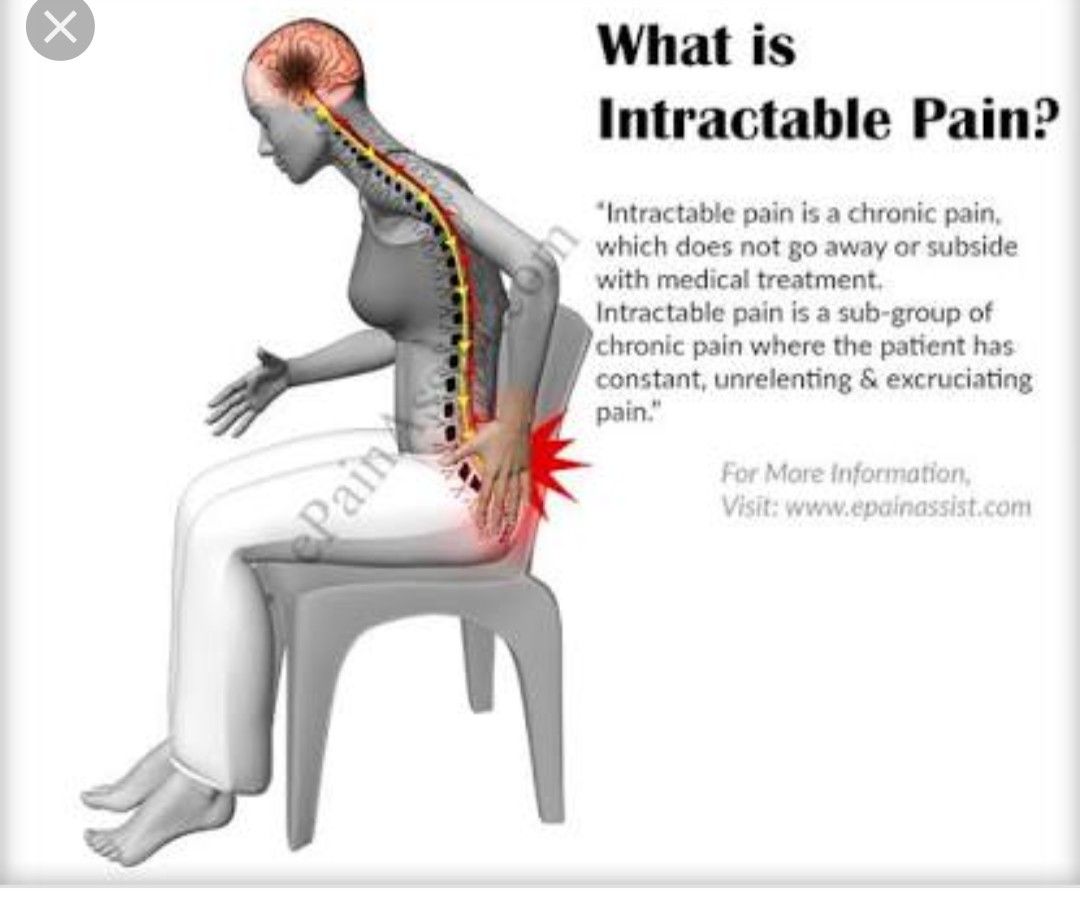
Some common symptoms of a cluster headache include:
- burning, stabbing pain behind or around one eye
- a red, teary eye
- a smaller, constricted pupil
- a drooping eyelid
- puffiness under or around one or both eyes
- runny or stuffy nose
- facial flushing
- feeling restless
Once you get the right diagnosis, migraine and cluster headaches can be treated and managed.
Medication overuse and head trauma can also cause pain on one side of the head.
A headache behind your eyes and nasal passages can be due to allergies, such as hay fever, which can also produce symptoms similar to that of the common cold.
However, true sinus headaches tend to be rare. These headaches usually turn out to be migraine, which can cause pain over the sinuses.
A headache behind your eyes is rarely related to eyestrain.
If you think you’re having sinus headaches, consider seeing your doctor to get a diagnosis. Your doctor can help determine if your headache is truly caused by allergies, or if it could be migraine.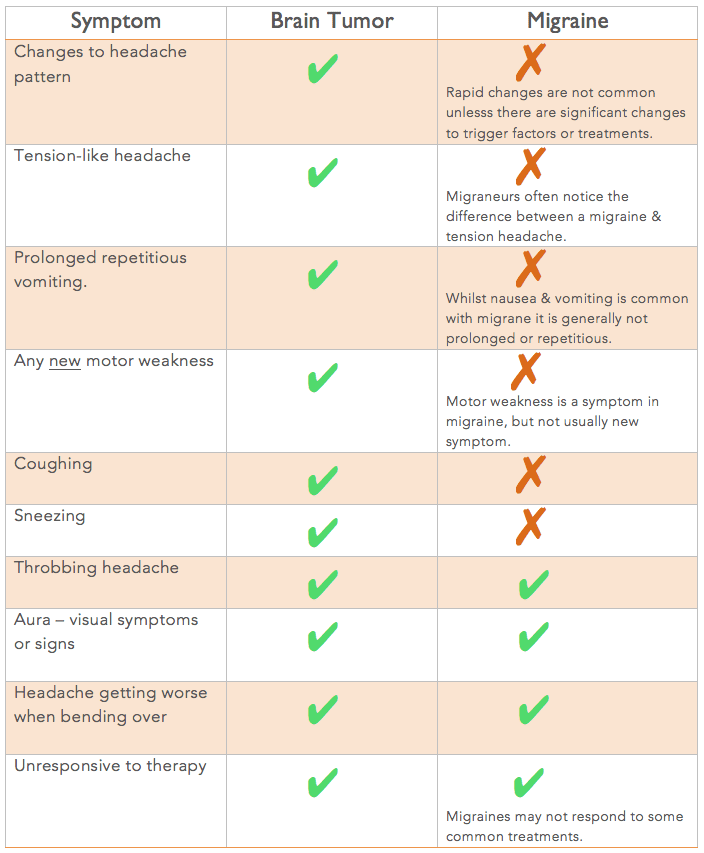
Pain in the back of your head can be due to arthritis of the neck. Pain tends to get worse when you move.
This type of headache can also be due to poor posture or neck problems such as a herniated disc.
A back of the head headache, often accompanied by neck pain, can also be a sign of a low-pressure headache, otherwise known as spontaneous intracranial hypotension (SIH). It’s caused by low spinal fluid pressure in the brain.
Another sign of SIH is that the pain eases when you lie down, but worsens when you:
- sit upright
- stand
- cough or sneeze
- strain
- engage in physical activity
This type of headache can occur following a lumbar puncture. If you’ve recently had this procedure and develop a headache, see your doctor as soon as possible for treatment.
If you have any type of chronic headache, it’s a good idea to contact your doctor or healthcare provider. Headaches are considered chronic if they happen 15 days or more per month.
By identifying your specific type of headache, your doctor can determine the best type of treatment. Getting the right kind of treatment for your headache may help improve your overall quality of life.
Sometimes, a headache can indicate a more serious medical condition such as:
- aneurysm
- stroke
- meningitis
- encephalitis (inflammation of the brain tissue)
- brain tumor
Signs that you may need immediate medical attention for a headache include:
- sudden onset of severe headache
- a rigid neck
- double vision
- weakness or paralysis on one side of your body
- numbness on either side of the body
- balance and coordination problems
- speech difficulties
- high fever
- lethargy
- reduced or altered consciousness level
- hallucinations
Everyone is different, so it may take some trial and error to figure out what works best for your headaches.
Here are some ways that you may be able to help ease your headache pain with self-care:
- Lie down in a dark, quiet room.
 Take a nap if you can.
Take a nap if you can. - Apply ice or a cold compress to the area that hurts. Some people find that heat works better.
- Drink water to stay hydrated.
- Do some deep breathing exercises.
- Take over-the-counter (OTC) nonsteroidal anti-inflammatories as directed. Be careful, because taking too many can lead to rebound headaches.
- Drink a little caffeine.
For chronic headaches, your doctor may prescribe medications based on the specific type of headache you have. These medicines include:
- triptans
- ergot derivative drugs
- combination analgesics and caffeine
Preventive medications for chronic headache include:
- anticonvulsants
- beta-blockers
- calcium channel blockers
- calcitonin gene-related peptide (CGRP) antagonists
- onabotulinumtoxinA (Botox)
- selective serotonin reuptake inhibitors (SSRIs)
- serotonin-norepinephrine reuptake inhibitors (SNRIs)
- tricyclic antidepressants
The area of your head that hurts can tell you something about the type of headache you’re having. Other symptoms and the frequency of your headache pain can tell you a lot more.
Other symptoms and the frequency of your headache pain can tell you a lot more.
If your headaches aren’t too severe or frequent, home remedies and OTC medicines may help get you through them.
If you get headaches frequently, or the pain disrupts your daily life, be sure to follow up with your doctor for a proper diagnosis and treatment.
A headache that’s accompanied by certain symptoms can be a sign of a more serious condition. If you have head pain with symptoms such as partial paralysis, high fever, blurred vision, or speech difficulties, call 911 or go to your local emergency room.
What Can It Tell You?
The location of your head pain can be an important clue in determining what type of headache you have and the potential remedies.
Headaches are very common. In fact, it’s estimated that about half to three quarters of adults have experienced some type of headache within the last year.
Chronic headache, which means 15 or more headache days every month, affects between 1.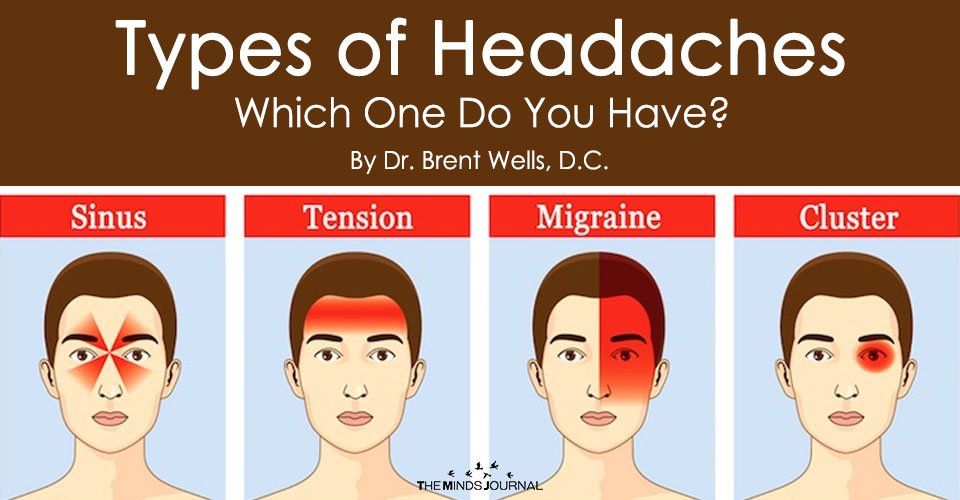 7 to 4 percent of adults.
7 to 4 percent of adults.
Let’s take a closer look at the most common types of headaches based on location, as well as when it’s important to seek medical care.
The whole-head headache can feel like there’s a tight band around your head. This often indicates a tension headache, the most common primary headache disorder.
However, it’s important to point out that there are times when migraine pain can be holocranial. This means the pain can be felt around the head instead of just on one side.
With a tension headache, pain and pressure may extend to your neck, and you may also feel pain and tenderness around your forehead.
Tension headaches are caused by muscle contractions in your head and neck. This type of headache tends to last a few hours, but can linger for days.
A tension headache can be caused by stress or neck problems. However, you might also have an all-over headache from:
- caffeine withdrawal
- physical exertion
- hunger
- hangover
- fatigue
- having a cold or flu
- head trauma
- eye strain or staring at a computer for too long
- using too much headache medicine, also known as rebound headache
An occasional tension headache doesn’t typically require medical attention. Do see your doctor if you experience 15 or more headache days per month.
Do see your doctor if you experience 15 or more headache days per month.
Migraine
Whether it’s the left side or the right side, one-sided head pain often indicates migraine.
Migraine is a primary headache disorder that causes recurrent attacks. Symptoms of migraine typically include:
- throbbing, pulsating pain
- nausea or vomiting
- aura
- noise, light, and odor sensitivities
- difficulty focusing
Migraine can be caused by a variety of contributing factors, including changes in brain chemicals. In particular, a decrease in serotonin levels.
Many other factors may also trigger an attack, such as:
- loud sounds
- bright or flashing lights
- specific odors
- certain foods
- changes in weather conditions
- lack of sleep
- hormonal changes
- skipping meals
- dehydration
These triggers vary from person to person. It can even be a combination of factors that bring on an attack.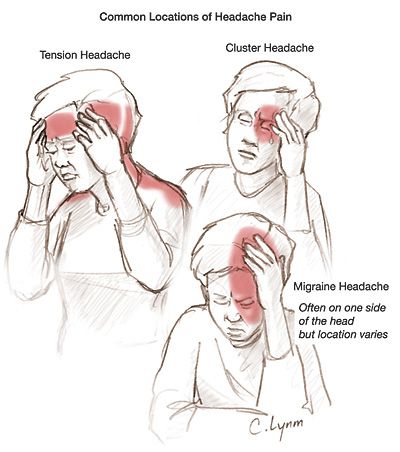 It’s not always possible to identify triggers.
It’s not always possible to identify triggers.
Cluster headache
Cluster headache is another primary headache disorder that causes pain on one side of the head.
The pain is often located behind or around one of your eyes. In some cases, the pain may spread to your forehead, side of your head, nose, neck, or shoulders on the same side.
Cluster headaches tend to occur in cycles or, as the name suggests, “clusters.” You may experience headaches for a few weeks or months, followed by a remission period.
These headaches often come on suddenly and the pain usually becomes severe within about 10 minutes of starting.
Some common symptoms of a cluster headache include:
- burning, stabbing pain behind or around one eye
- a red, teary eye
- a smaller, constricted pupil
- a drooping eyelid
- puffiness under or around one or both eyes
- runny or stuffy nose
- facial flushing
- feeling restless
Once you get the right diagnosis, migraine and cluster headaches can be treated and managed.
Medication overuse and head trauma can also cause pain on one side of the head.
A headache behind your eyes and nasal passages can be due to allergies, such as hay fever, which can also produce symptoms similar to that of the common cold.
However, true sinus headaches tend to be rare. These headaches usually turn out to be migraine, which can cause pain over the sinuses.
A headache behind your eyes is rarely related to eyestrain.
If you think you’re having sinus headaches, consider seeing your doctor to get a diagnosis. Your doctor can help determine if your headache is truly caused by allergies, or if it could be migraine.
Pain in the back of your head can be due to arthritis of the neck. Pain tends to get worse when you move.
This type of headache can also be due to poor posture or neck problems such as a herniated disc.
A back of the head headache, often accompanied by neck pain, can also be a sign of a low-pressure headache, otherwise known as spontaneous intracranial hypotension (SIH). It’s caused by low spinal fluid pressure in the brain.
It’s caused by low spinal fluid pressure in the brain.
Another sign of SIH is that the pain eases when you lie down, but worsens when you:
- sit upright
- stand
- cough or sneeze
- strain
- engage in physical activity
This type of headache can occur following a lumbar puncture. If you’ve recently had this procedure and develop a headache, see your doctor as soon as possible for treatment.
If you have any type of chronic headache, it’s a good idea to contact your doctor or healthcare provider. Headaches are considered chronic if they happen 15 days or more per month.
By identifying your specific type of headache, your doctor can determine the best type of treatment. Getting the right kind of treatment for your headache may help improve your overall quality of life.
Sometimes, a headache can indicate a more serious medical condition such as:
- aneurysm
- stroke
- meningitis
- encephalitis (inflammation of the brain tissue)
- brain tumor
Signs that you may need immediate medical attention for a headache include:
- sudden onset of severe headache
- a rigid neck
- double vision
- weakness or paralysis on one side of your body
- numbness on either side of the body
- balance and coordination problems
- speech difficulties
- high fever
- lethargy
- reduced or altered consciousness level
- hallucinations
Everyone is different, so it may take some trial and error to figure out what works best for your headaches.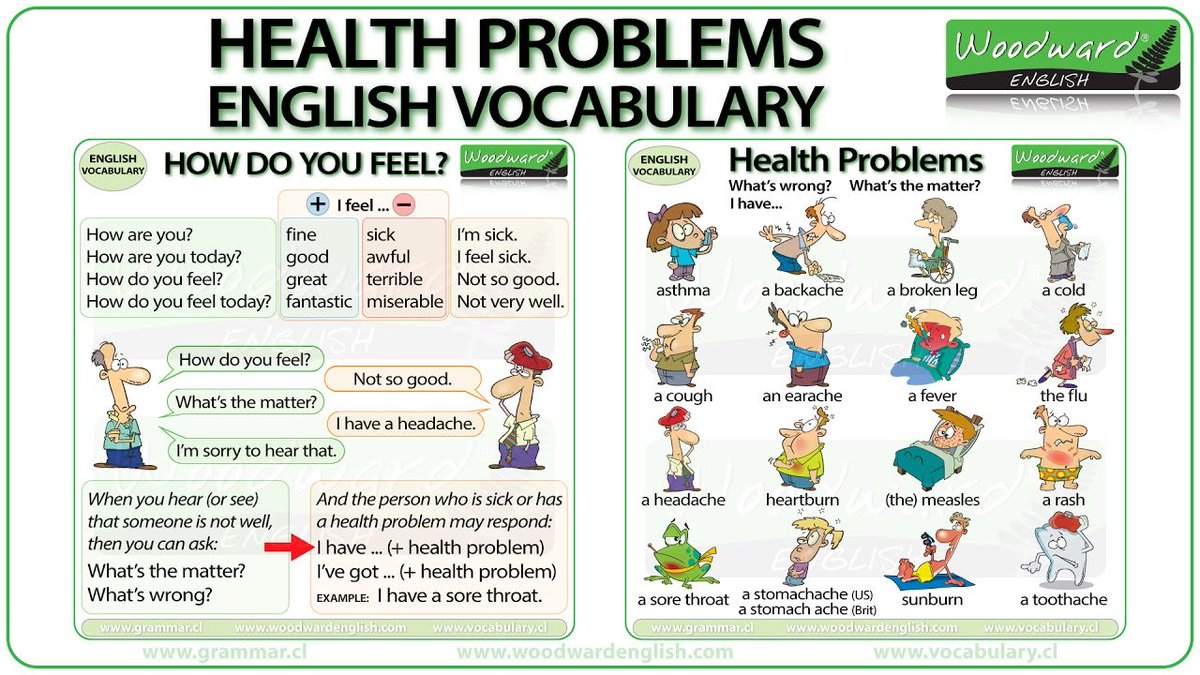
Here are some ways that you may be able to help ease your headache pain with self-care:
- Lie down in a dark, quiet room. Take a nap if you can.
- Apply ice or a cold compress to the area that hurts. Some people find that heat works better.
- Drink water to stay hydrated.
- Do some deep breathing exercises.
- Take over-the-counter (OTC) nonsteroidal anti-inflammatories as directed. Be careful, because taking too many can lead to rebound headaches.
- Drink a little caffeine.
For chronic headaches, your doctor may prescribe medications based on the specific type of headache you have. These medicines include:
- triptans
- ergot derivative drugs
- combination analgesics and caffeine
Preventive medications for chronic headache include:
- anticonvulsants
- beta-blockers
- calcium channel blockers
- calcitonin gene-related peptide (CGRP) antagonists
- onabotulinumtoxinA (Botox)
- selective serotonin reuptake inhibitors (SSRIs)
- serotonin-norepinephrine reuptake inhibitors (SNRIs)
- tricyclic antidepressants
The area of your head that hurts can tell you something about the type of headache you’re having. Other symptoms and the frequency of your headache pain can tell you a lot more.
Other symptoms and the frequency of your headache pain can tell you a lot more.
If your headaches aren’t too severe or frequent, home remedies and OTC medicines may help get you through them.
If you get headaches frequently, or the pain disrupts your daily life, be sure to follow up with your doctor for a proper diagnosis and treatment.
A headache that’s accompanied by certain symptoms can be a sign of a more serious condition. If you have head pain with symptoms such as partial paralysis, high fever, blurred vision, or speech difficulties, call 911 or go to your local emergency room.
How to prepare for a visit to a headache specialist
Despite the fact that you have a lot of worries and you have been planning to go to the doctor for a long time, in the doctor’s office you do not know where to start. The situation is common for many diseases, including headaches. What can you do as a patient to make your visit to a specialist as effective as possible?
Think about the history of your headaches.
Since most headaches are diagnosed only on the basis of the clinical picture (that is, the description of the course of the disease), the doctor will ask you different questions.
Video
See all
What is migraine and how to deal with it. Lecture by a neurologist-cephalologist.
Migraine. Problems of diagnosis and treatment. Lecture for neurologist Yulia Azimova
Why do we have a headache? How to treat a migraine? Neurologist Kirill Skorobogatykh
- When did your headaches start to bother you or have a significant impact on your life? (since adolescence, after pregnancy, since last summer, since yesterday
- How often do headaches occur and how often is the headache severe enough to interfere with your daily activities? The simplest headache diary or calendar, which can be found in the appropriate section of information for patients, provides indispensable data for the doctor.
 Try keeping a diary for a month before your doctor’s appointment, then bring it to your appointment.
Try keeping a diary for a month before your doctor’s appointment, then bring it to your appointment. - What is the nature of your headache? (typical duration of an attack, the nature of the pain – pulsating, squeezing, shooting, localization of pain, other symptoms – nausea, increased sensitivity to light, sounds, redness of the eye, nasal congestion, etc.).
- Has your headache pattern and frequency changed lately? (if so, what changes have occurred?)
- What medicines have you tried to use both to relieve headaches and to prevent their occurrence? Your assessment of the effectiveness of the previous treatment. What headache medications are you currently using?
- What additional examinations did you have for headaches (computed tomography, magnetic resonance imaging, angiography, etc.)?
- What headache medicines do you currently use? How often do you take headache medication?
- Do you have other chronic diseases? If so, what medications are you taking for this condition?
Bring your most important and recent medical records to your appointment. But do not overdo it – the doctor will not have time to study your children’s outpatient card!
But do not overdo it – the doctor will not have time to study your children’s outpatient card!
Get some general information about headaches before you visit your doctor. Be prepared to ask questions that interest you: Do you need preventive treatment? What should you do if you vomit during an attack and cannot take a pill? What are the side effects of the prescribed treatment? What non-drug treatment can be used? what can be used to treat migraine during pregnancy? [2, 5]
Therefore, in order to optimize your visit to the doctor, it is necessary to obtain basic information about the headache before the visit, tell the doctor about the history of the development of your headache on the points indicated and provide the most important medical documents. If your doctor has experience in managing patients with headache, this will greatly increase the accuracy of the diagnosis and help prescribe the optimal treatment [3].
Read more articles about headaches in our Telegram channel./ativan-withdrawal-symptoms-4588394_final-6bb2e0e1202b4092ba7297c475a8509f.png)
References:
- Tarasova S.V. “Prevalence, diagnosis of various forms of daily headache and their pharmacotherapy”. // Aftoref. Diss. Kmn. – 2008.
- Evans R.W, Evans R.E. “Expert opinion: what causes migraine: which physician explanation do patients prefer and understand?” // Headache. – 2009. – v.49. – p.1536-1540.
- Hahn S.R., Lipton R.B., Sheftell F.D., et al. Healthcare provider-patient communication and migraine assessment: results of the American Migraine Communication Study, phase II. // Curr Med Res Opin. – 2008. – v.24. – p.1711-1718
- Rothrock J.F. “Your visit to the doctor: achieving a satisfactory result”. // Headache – 2009. – v.49. – p.495-496
- Smith T.R., Nicholson R.A., Banks J.W. “Migraine education quality improves of life in a primary care setting”. // Headache. – 2010. – v.50. – p.600-512.
- Tassorelli C.
 , Sances G. Allena M., et al. “The usefulness and applicability of a basic headache diary before first consultation: results of a pilot study conducted in two centres”. // Cephalalgia. – 2008. – v.28. – p.1023-1030.
, Sances G. Allena M., et al. “The usefulness and applicability of a basic headache diary before first consultation: results of a pilot study conducted in two centres”. // Cephalalgia. – 2008. – v.28. – p.1023-1030.
Monoclonal antibodies for the treatment of migraine
migraine provocateurs
aura migraine
Chronic migraine
Menstrual migraine
Treatment of a migraine attack
Opiates/opioids (“narcotic analgesics”) for migraine relief
How to Prepare for a Visit with a Headache Specialist
Triptans
Non-steroidal anti-inflammatory drugs (NSAIDs) to treat a migraine attack
Treatment of a migraine attack with combined painkillers
Classification of headaches
Migraine Prevention
Headache from painkillers (abuses)
Neurologist at SM-Clinic spoke about the possible causes of pain in the back of the head
Neck pain is a fairly common problem. And she has many reasons. Therefore, it is important to find their problems in order to feel relief. Let’s find out together with a specialist how to do it.
And she has many reasons. Therefore, it is important to find their problems in order to feel relief. Let’s find out together with a specialist how to do it.
Headaches in the back of the head can have several different causes. For example, it may only be muscle damage due to a minor injury, or it may be a secondary symptom of other pathologies. The type and location of the pain can play a crucial role in diagnosing the cause. If the pain is severe and recurring, be sure to consult a doctor.
Causes of pain in the back of the head in an adult
– By itself, pain in the back of the head does not indicate the cause of this pain, – explains neurologist Elena Gaivoronskaya. – The doctor evaluates the frequency of pain, its intensity, duration, nature (throbbing, pressing, stabbing), concomitant symptoms. Only on the basis of all these data can a diagnosis be made.
There are a number of reasons why headaches may occur predominantly in the back of the head.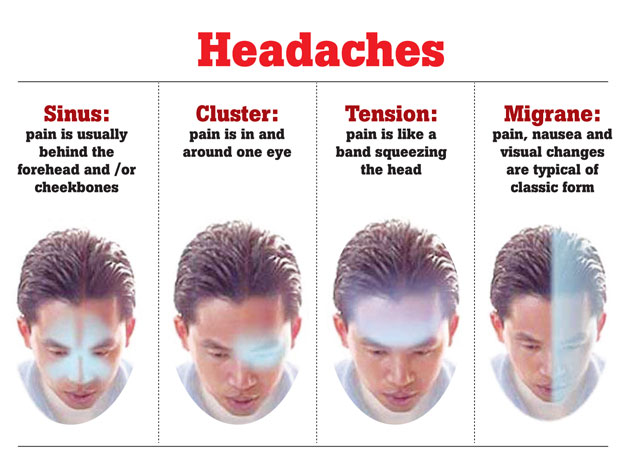
G tension pains. This is the most common cause of neck pain. Such pain can last from 30 minutes to 7 days. Such pain can be caused by severe stress, overwork, lack of sleep, malnutrition, poor posture, or insufficient water intake.
Patients with this problem usually feel tension in the back of the head or front of the head. The pain can range from dull to severe.
Migraine. Another common type of headache that often begins in childhood and worsens with age. Migraine is most common in women. Its symptoms include severe pain on one side of the head with nausea, vomiting, and blurred vision. Patients are usually sensitive to light, noise or smell. Physical activity can make the pain worse. It can last from several hours to several days.
Causes of migraine – emotional or physical stress, environmental and nutritional changes. Sometimes medications (such as birth control pills) can also trigger a migraine.
Drug overuse or recurrent headache. These headaches can develop if a person takes too many painkillers. They are very strong and are often accompanied by nausea, restlessness, irritability, fatigue, difficulty concentrating, memory loss and even depression.
These headaches can develop if a person takes too many painkillers. They are very strong and are often accompanied by nausea, restlessness, irritability, fatigue, difficulty concentrating, memory loss and even depression.
Occipital neuralgia. Rare but severe headache that usually starts at the base of the neck and extends to the back of the head and then behind the ears. Often occurs when the occipital nerves, which travel up the back of the neck to the base of the skull, are damaged or irritated. The pain is accompanied by a burning or shooting sensation and persists on one side of the head, but is often aggravated by movement of the neck. The patient is usually sensitive to light.
Possible causes include spinal injury, tumors, nerve damage caused by diabetes, swelling of blood vessels, and rarely infection.
Headaches on exertion. They occur as a result of stressful activity and often occur after exercise. Such pain resembles a heartbeat and can last from 5 minutes to 2 days.
Often occurs after heavy weight exercise or running. But sometimes they happen after intercourse or attempts in the toilet.
Arthritis headache. It appears in the occiput and is aggravated by movement. May be the result of arthritis of the first, second, or third vertebrae. Either it is associated with changes in the bone structure of the neck or inflammation of the blood vessels in the head.
In addition, the cause of a headache in the back of the head can be:
- osteochondrosis of the cervical spine;
- high blood pressure;
- increased intracranial pressure;
- stress;
- brain tumors;
- cerebral aneurysm;
- subarachnoid cerebral hemorrhage;
- injuries of the cervical spine and craniocerebral injuries;
- meningitis.
Treatment for pain in the back of the head in an adult
As a rule, headaches in the back of the head are treated with anti-inflammatory drugs, muscle relaxants, or both.
Diagnostics
First, the doctor must determine the cause of the pain in the back of the head. Often they are not secondary, that is, they are a symptom of some other disease. For example, you can block the nerve endings in the neck and if this stops the headache, then the problem is in the neck.
Modern treatments
Treatment methods depend on the diagnosis.
Tension headaches. They are usually treated with pain medication, massage, and sometimes meditation. However, frequent tension headaches require medical supervision.
Migraine. Treatment for this disease includes pain medication and rest in a darkened room. Doctors often recommend lifestyle changes, hormone therapy, and anti-migraine medications such as triptans to reduce the frequency and intensity of migraines.
Recurrent pains. The best treatment for this type of pain is to stop taking painkillers. Yes, at first the headaches get worse, but quickly pass.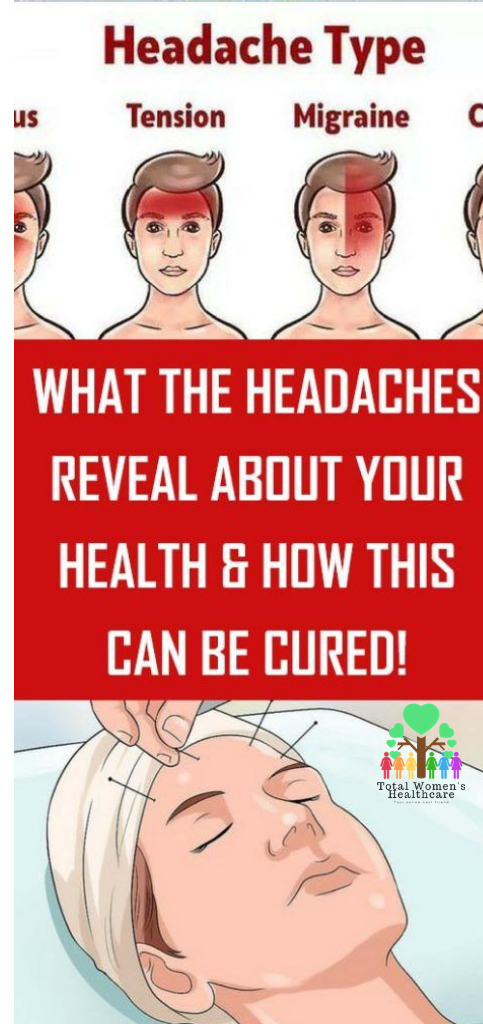
In severe cases, see a doctor – physical or behavioral therapy may be needed to break the habit of using analgesics.
Occipital neuralgia. It is treated with heat compresses, rest, massage, physical therapy, or pain medication. Severe pain may require oral muscle relaxants, nerve blocks, steroid injections, or local anesthesia. Rarely, surgery is needed to relieve pressure on the nerves or block pain signals from reaching that part of the body.
Pain on exertion. This problem can be solved by taking painkillers before training. In addition, it is important to avoid stressful loads, eat right and get enough sleep.
Prevention of pain in the back of the head in an adult
If you slouch while sitting or standing, the muscles in the back of your head, upper back, neck, and jaw can tighten. It can also put pressure on the nerves in these areas. As a result, poor posture can cause tension headaches and pain in the back of the head.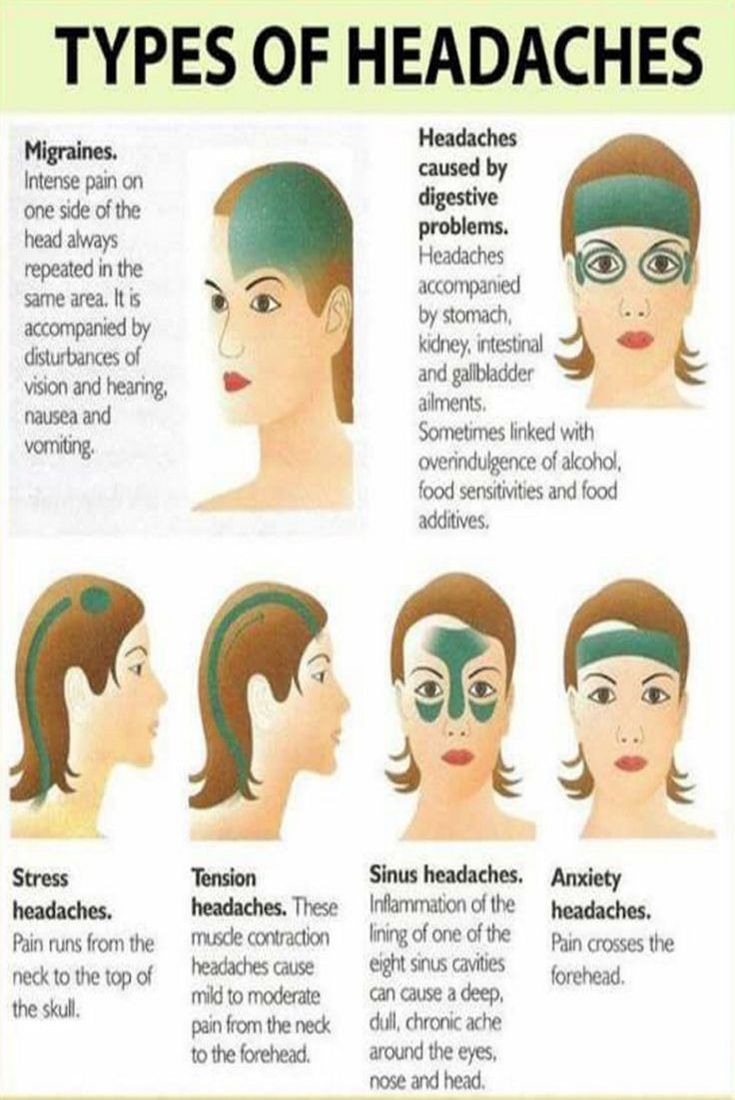
Standing or sitting upright can help relieve headaches due to bad posture.
Popular questions and answers
We asked neurologists to answer questions related to headache in the occipital region.
When can a headache in the back of the head be dangerous?
– Such symptoms, – says neurologist Olga Zincheva, – include:
- concomitant increase in body temperature;
- weakness, awkwardness;
- numbness and tingling in limbs or in one limb;
- prolonged increase in pressure, difficult to reduce;
- severe headaches;
- headaches accompanied by nausea and vomiting;
- double vision, impaired consciousness.
When to see a doctor for a headache in the back of the head?
– There are signs, – explains Olga Zincheva, – that require medical assistance:
- you have a headache for the first time for no apparent reason;
- pain lasts several days;
- have comorbidities.


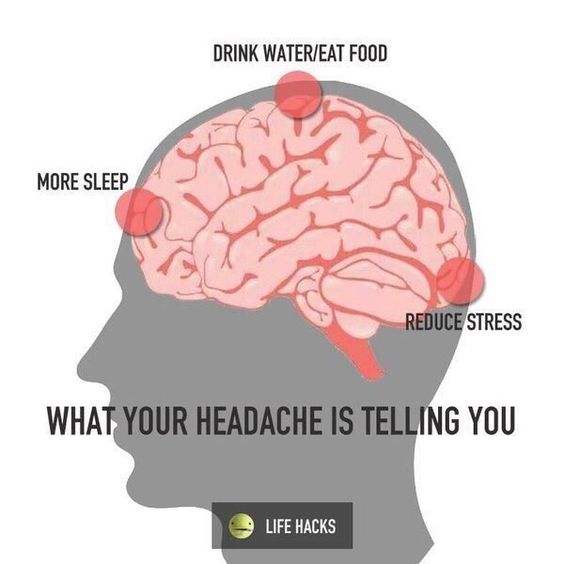 Take a nap if you can.
Take a nap if you can. Try keeping a diary for a month before your doctor’s appointment, then bring it to your appointment.
Try keeping a diary for a month before your doctor’s appointment, then bring it to your appointment.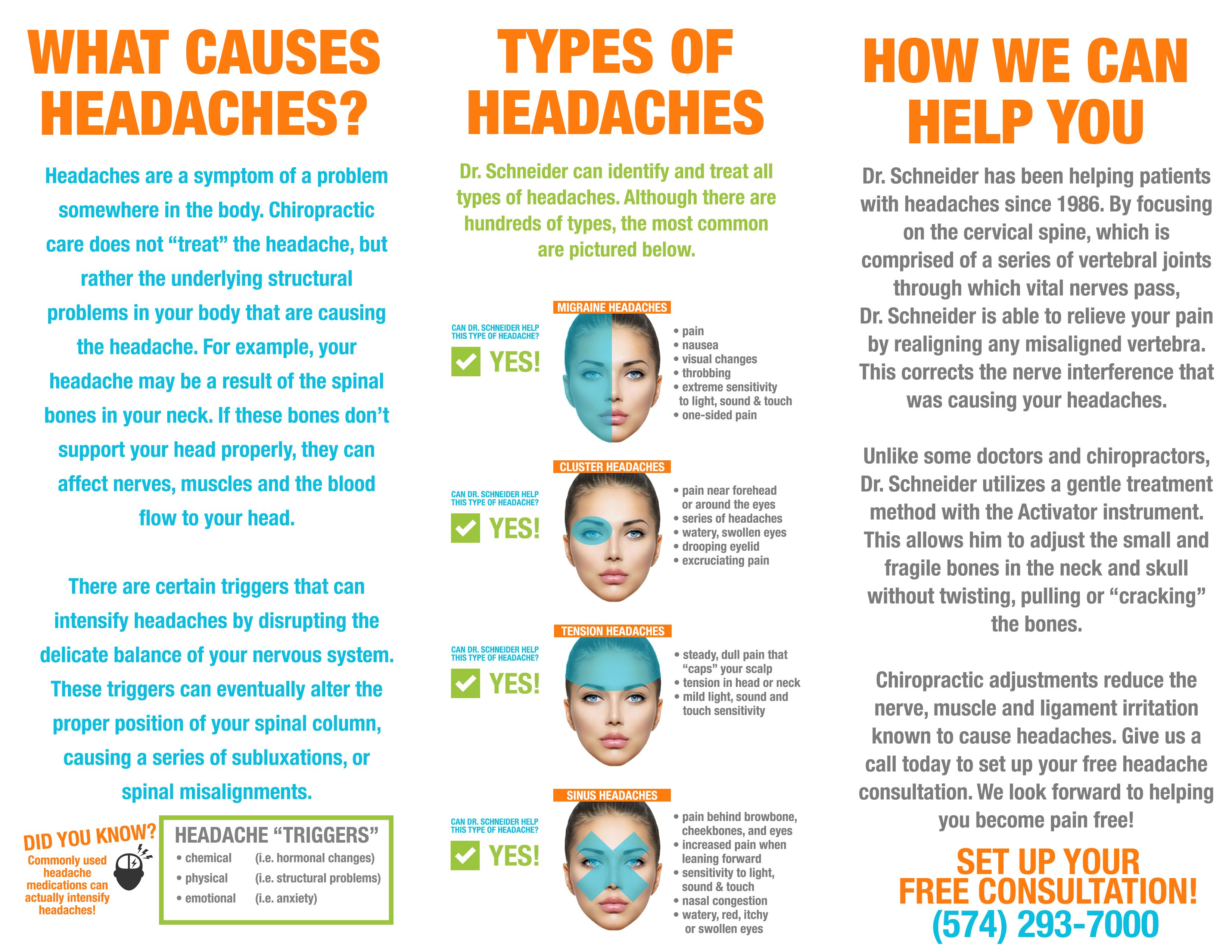 , Sances G. Allena M., et al. “The usefulness and applicability of a basic headache diary before first consultation: results of a pilot study conducted in two centres”. // Cephalalgia. – 2008. – v.28. – p.1023-1030.
, Sances G. Allena M., et al. “The usefulness and applicability of a basic headache diary before first consultation: results of a pilot study conducted in two centres”. // Cephalalgia. – 2008. – v.28. – p.1023-1030.